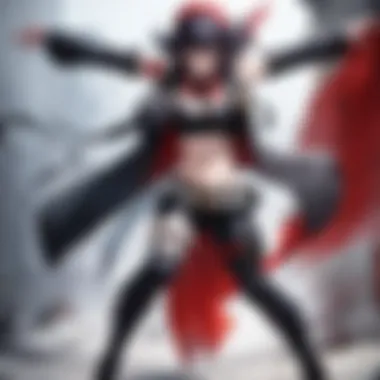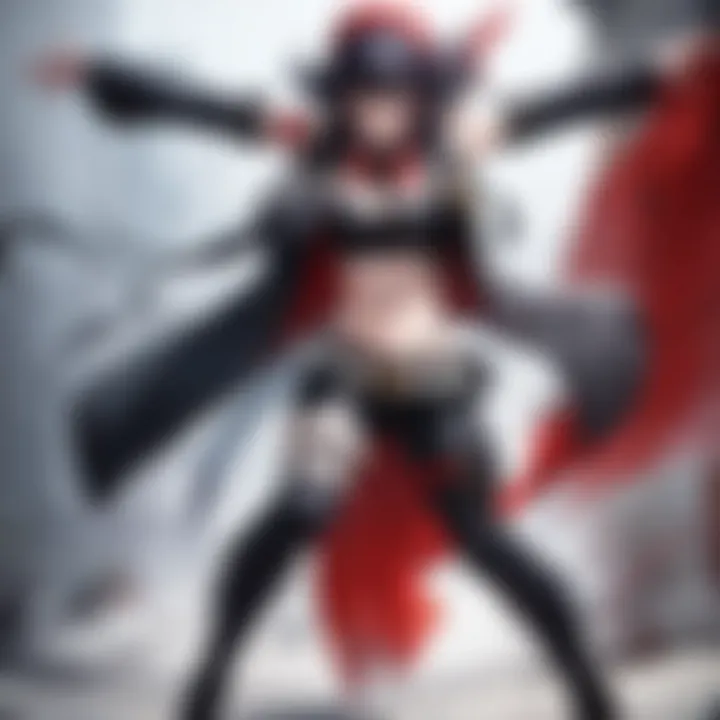In-Depth Analysis of Tokyo Revengers Season 1


Intro
Tokyo Revengers is not just another anime that rides the tide of time-travel narratives; it ventures into the raw emotions and intricate dynamics that define youth and rebellion. As viewers are whisked away into the tumultuous world of Takemichi Hanagaki, the protagonist, they encounter layers of complexity that linger long after the credits roll. In this exploration, we will dissect the character profiles that drive the story, unravel the central themes woven throughout the first season, and point out the cultural references that give context to its narrative depth.
The journey we embark on aims to provide anime and manga enthusiasts with a profound understanding of why Tokyo Revengers resonates so deeply with its audience. Whether it’s the gripping gang dynamics or the heart-wrenching emotional struggles depicted, there's much to uncover.
Character Profiles
Overview of Main Characters
At the heart of Tokyo Revengers lies a gripping tale that revolves around its main characters, each embodying a unique facet of youthful experience.
- Takemichi Hanagaki: The series mirrors Takemichi's odyssey from a dilapidated 26-year-old man to a heroic figure navigating time to save those he loves. He might seem like an underdog at first, but he embodies resilience, often fighting against the odds.
- Hinata Tachibana: She represents motivation and hope for Takemichi, driving him forward in his quest. Her character serves as the pivotal anchor, the harbinger of his transformation.
- Manjiro "Mikey" Sano: The charismatic leader of the Tokyo Manji Gang, Mikey is enigmatic and fiercely loyal. His complexities emerge through his leadership style, which often toes the line between benevolence and ruthlessness.
- Ken "Draken" Ryuguji: The vice-leader of the gang and Mikey's right-hand man, Draken's loyalty and strength command respect. His character contributes depth to the group dynamics that the story intricately crafts.
Supporting Characters
Supporting characters in Tokyo Revengers add a rich layer to the main narrative, often serving as catalysts for Takemichi’s growth.
- Tetta Kisaki: A cunning antagonist whose ambition knows no bounds, Kisaki’s manipulations create significant obstacles for Takemichi's journey.
- Pah-chin and Peh-yen: Representing the varied personalities within the gang, their interactions provide glimpses into the camaraderie that binds these youths even amidst strife.
Together, these characters weave a narrative that heightens the stakes of each time shift, presenting the audience with a multifaceted view of loyalty, despair, and growth.
Theme Exploration
Central Themes
The thematic foundation of Tokyo Revengers is anchored on several core elements that reflect the struggles and aspirations of its characters.
- Time Travel: This is more than a plot device; it signifies the chance to right past wrongs, instilling hope that one's choices can lead to redemption.
- Gang Dynamics: An exploration into brotherhood, loyalty, and the often harsh realities of youth in gangs, giving the series a gritty realism.
- Emotional Struggles: Characters don’t just face external conflicts but also confront inner battles stemming from fear, regret, and love, adding layers to their development.
Cultural References
The series subtly incorporates significant cultural references that ground the narrative in reality:
- Youth Subcultures in Japan: The depiction of gangs harkens back to the tumultuous youth subcultures that have historically shaped Japan, drawing upon real societal issues.
- 1990s Nostalgia: The era specifies a particular contextual backdrop for the characters’ style, lingo, and aspirations, providing a nostalgic glimpse into that time.
By exploring these themes, Tokyo Revengers elevates itself beyond pure entertainment, becoming a commentary on growth, resilience, and the trials of growing up.
Popular Series and Recommendations
As Tokyo Revengers has grabbed the attention of anime enthusiasts, several other series and manga deserve mention in this context:
- Top Anime Series of the Year: Titles such as Attack on Titan and Jujutsu Kaisen have also made waves this year, appealing to similar audiences with their gripping narratives.
- Hidden Gems in Manga: For those seeking depth like that found in Tokyo Revengers, titles such as Blue Lock and Tokyo Ghoul provide rich character studies and engaging plots.
Through Tokyo Revengers, fans are invited to engage not only with its story but also with the broader conversations it fosters within the realm of anime and manga.
Prelude to Tokyo Revengers
Understanding the landscape of any narrative is a crucial step in unpacking its significance. Tokyo Revengers, despite its vibrant exterior, offers a multilayered examination of human emotion and societal constructs. The first season sets the stage for a tale steeped in regret, resilience, and the trials of youth against a backdrop of gang culture and time travel—a combination that compels viewers to engage deeply with both characters and themes.
Overview of the Anime
At its core, Tokyo Revengers is not just another action-packed anime. It revolves around Takemichi Hanagaki, a man down on his luck who suddenly finds himself transported back to his middle school days. The anime thrives on this core premise, juxtaposing the innocence of youth with the heavy burdens of adulthood. The central conflict arises from Takemichi's quest to save his ex-girlfriend, Hinata, and, in the process, alter the dark course of his life. The show's narrative structure moves fluidly through timelines, creating a unique viewing experience that hooks audiences from the start. It doesn’t shy away from exploring pivotal emotional arcs, granting its characters a depth that resonates well beyond the screen.
Among the remarkable features of the anime is its ability to blend genres—elements of science fiction meet grounded storytelling that speaks to the challenges faced by many young people today. This fusion is not merely for spectacle; it enhances the relatability of the characters and their struggles, making it a compelling watch for fans of various genres.
Source Material: The Manga
Tokyo Revengers finds its roots in the manga created by Ken Wakui. First serialized in 2017, the source material has garnered a dedicated following, and for good reason. The manga’s storytelling is rich and detailed, providing a broader context for the unfolding drama in the anime. It explores intricate relationships and character backgrounds that often get skimmed over in the adaptation.
The manga isn’t just a backstory; it is a powerhouse of emotion and visual artistry. Each panel captures the rawness of youth’s struggles with friendships, heartbreaks, and identity crises. Readers are given a deeper dive into the characters' motivations and emotional landscapes.
As an adaptation, the anime has remained relatively faithful to the manga’s essence, capturing much of its emotional heart. However, adaptations inevitably bring their own flair, translating static images into vivid motion and sound—elements that only enhance the manga’s powerful narrative.
"A good adaptation should stand on its own while still respecting the source material. Tokyo Revengers succeeds in marrying both worlds seamlessly."
The popularity of the manga undoubtedly paved the way for the anime's success. It established a robust fanbase eager for the nuances of Takemichi’s journey and the broader themes of friendship and loyalty. As the first season of the anime unfolds, it continues to draw on the established lore, shaping the narrative like a sculptor refining a masterpiece.
By exploring these foundational elements, the article garners greater insight into how Tokyo Revengers captures the imagination of its audience, bridging the gap between youthful fervor and mature reflections on life.
Ultimately, this introduction serves as a gateway for readers who are eager to explore the intricate depth and richness encapsulated within Tokyo Revengers, whether through its anime form or as a celebrated manga.


Plot Synopsis of Season
The plot synopsis of a show like Tokyo Revengers is more than just a summary; it forms the backbone of understanding why the series resonates with its audience. In this section, we delve into how the intricate plot unfolds and the impact it has on character development and thematic exploration. A solid grasp of the plot can heighten appreciation for the stakes involved and the motivations driving the characters. By dissecting the narrative arc, one can recognize the delicate interplay between time travel, relationships, and conflict that draws viewers back to this engaging narrative.
The Premise
At its core, the premise of Tokyo Revengers centers around Takemichi Hanagaki, a thirty-something man stuck in a rut. His life is a far cry from what he envisioned during his youth; instead of conquering the world, he finds himself working a dead-end job, living in a cramped apartment, and grappling with the memory of his first love—Hinata Tachibana.
This all changes one fateful day when Takemichi learns of Hinata's tragic death at the hands of a gang known as Toman. Feeling a surge of regret and yearning to make things right, he takes the unthinkable step of jumping in front of a train. Instead of meeting his demise, he inexplicably travels back twelve years into his past. This shocking twist sets the stage for his journey through time, as Takemichi tries to navigate the dangers of his former life while seeking to alter the future.
The hook lies in how Takemichi uses his knowledge of events yet to unfold, hoping to steer not just his destiny but also the fates of his friends. This high-stakes narrative unfolds themes such as redemption, friendship, and the lasting consequences of choices made, making it a rich ground for exploration.
Main Arcs and Events
As the season unfolds, several key arcs emerge, each contributing significantly to Takemichi's quest for redemption:
- The Initial Dilemma: Early episodes introduce Takemichi’s challenge—navigating his old friends, who are now members of the dangerous Toman gang. The initial confrontations highlight the stark contrast between his naïve past self and the struggles of his adult life.
- The Formation of Alliances: As Takemichi reconnects with his former buddies, he forges alliances, particularly with Draken and Ken Ryuguji, two formidable figures within Toman. Their bonds deepen, creating a blend of camaraderie and tension that drives the plot forward.
- The Gang Wars: The conflict escalates with rival gangs, forcing Takemichi to strategize not only to protect his friends but also to alter pivotal events that lead to catastrophic outcomes. Viewers witness emotionally charged moments when loyalties are tested, and sacrifices are made.
- Climactic Battles: Each arc builds toward intense confrontations, where Takemichi must make life-altering decisions that showcase both his growth as a character and the underlying theme of sacrifice. The stakes couldn't be higher, as the line between ally and enemy blurs.
- Resolution and Reflection: Season one encapsulates a rollercoaster of emotions but concludes with threads left open, illuminating the complex nature of time travel and its consequences. Takemichi’s evolution from a passive bystander to a proactive hero serves as an anchor point for future explorations.
Character Analysis
In the world of Tokyo Revengers, character development plays a pivotal role in driving the narrative. Understanding the characters' motives, relationships, and growth arcs is essential for appreciating the layers of the story. The protagonist and supporting cast don't just represent typical archetypes; they embody the emotional turmoil, struggles, and personal triumphs that resonate with viewers, particularly the youth. A deep dive into their complexities reveals the intricate web of loyalty, strength, and vulnerability that binds them together. Through this analysis, readers can grasp how each character amplifies the overarching themes of redemption and friendship that are central to the series.
Protagonist: Takemichi Hanagaki
Takemichi Hanagaki stands at the core of Tokyo Revengers. He is a seemingly meek character, often regarded as unremarkable by most of his peers. However, his apparent weakness masks an unyielding spirit that becomes increasingly evident as the story progresses.
Takemichi's journey through time not only serves to alter the past but also to empower his character. He repeatedly faces danger, betrayal, and emotional strife. This relentless battle against adversity reveals his dedication to his friends and the lengths he is willing to go for their sake. Takemichi’s growth from a timid bystander to a determined leader exemplifies the transformative power of friendship and courage. His flaws make him relatable, as he stumbles and learns — a testimony to the idea that resilience is not the absence of fear but the determination to push through it.
Supporting Characters
Supporting characters in Tokyo Revengers add further depth and dimension to the plot and enhance Takemichi's development through their unique traits and contributions. They aren't just side notes; rather, they provide crucial perspectives and, at times, lessons that dramatically impact the overall narrative.
Draken: The Loyal Ally
Draken, or Ken Ryuguji, embodies loyalty. He stands as a rational pillar within the chaotic world of gang fights. His commitment to his friends, especially to Takemichi, exemplifies steadfastness in a turbulent environment.
A notable characteristic of Draken is his fierce protectiveness over those he loves. This trait makes him a beneficial character, as his motivations often drive the plot forward, pushing Takemichi to become better than he imagines himself to be. What separates Draken is his unique blend of toughness and vulnerability, showing that true strength lies in caring for others. Plus, his striking tattoo symbolizes a deeper connection to his crew, offering a visual representation of the bonds that are central to gang culture in the narrative.
Emma: The Heart of the Gang
Emma stands out as the emotional anchor of the group. Serving as both a sister and a love interest, she offers a sense of warmth in the intense, often gritty atmosphere of gang rivalries.
Emma's key characteristic is her unwavering support for both Draken and Takemichi, which showcases her role as a beneficial character in fostering relationships among gang members. She often acts as the bridge during conflicts, emphasizing themes of unity and understanding. Emma's uniqueness lies in her ability to remain true to herself, even against the backdrop of violence. However, her character depth also introduces an element of vulnerability, as her affection for the boys can lead to emotional turmoil in the face of danger.
Ken Ryuguji: The Fierce Fighter
Although Ken Ryuguji is known primarily by his nickname Draken, in discussions of the character, one cannot overlook his fierce fighting prowess. This resoluteness underlines not only his ability to protect his friends but also defines him as a symbol of resistance against the trials of their world.
Ken's utmost bravery showcases his protective nature which endears him to viewers. His reputation as a strong fighter adds layers to the character dynamics, encouraging Takemichi to step up in situations where he's tempted to shy away. Ken’s complicated past and the weight of leadership encapsulate the challenges faced by many young men in today’s society, making him a compelling character that resonates deeply with audiences. His combat skills serve to reinforce his role as a protector and bring an aggressive realism to the story.
Themes Explored
The themes within Tokyo Revengers offer an intricate layer of depth that supports the series' narrative structure. As viewers navigate through Takemichi’s journey, they are invited to ponder critical elements shaping human relationships and the moral dilemmas that arise in life's tumultuous moments. Each theme resonates with audience members, fostering a connection that enhances their experience. Here, we'll delve into three pivotal themes: Time Travel and Redemption, Friendship and Loyalty, and Conflict and Violence.
Time Travel and Redemption
Time travel plays a crucial role in the plot of Tokyo Revengers, acting like a double-edged sword. The concept not only propels Takemichi through various timelines but also serves as a metaphor for second chances. Through this lens, viewers can consider what it means to seek redemption. Takemichi’s repeated efforts to alter past events reflect the human desire to correct mistakes and mend broken bonds.
- Regret and Forgiveness: The necessity of confronting past choices encourages reflection on personal accountability. As Takemichi revisits key moments that led to catastrophic outcomes, he embodies a relatable struggle many experience in wanting to avoid regret.
- Cycle of Change: This theme also highlights the persistent cycle of change. Every attempt to rewrite history doesn’t guarantee a favorable outcome, demonstrating that redemption is not guaranteed, but rather earned through resilience and growth.
"Ultimately, the journey of attempting to change the past reveals that it’s not merely about altering events but understanding the reasons behind them."
Friendship and Loyalty
Friendship and loyalty decorate the landscape of Tokyo Revengers, forming the backbone of the series' emotional core. As Takemichi navigates through turbulence, the relationships he forms are tested in intricate ways.
- Bonds forged in adversity: Takemichi's friendships with characters like Draken serve as a reminder that loyalty often blossoms in the face of adversity. Their unwavering support shows how profound connections can provide strength to confront overwhelming odds.
- Sacrifices and Consequences: These themes also unfold through moments of sacrifice. Characters often face tough choices where loyalty may clash with personal safety. Such tensions present an authentic portrayal of how real-life friendships can be complicated, demanding one to weigh the costs against the depth of their loyalty.
Conflict and Violence
Conflict and violence form a harsh, yet significant part of Tokyo Revengers. With gang culture as a central element, the series brings forth the harsh realities of youth engaging in dangerous lifestyles.
- Violence as a catalyst: The constant threat of violence acts as a catalyst for character growth. Takemichi's encounters push him to ascertain his values and what he is willing to protect.
- Consequences of aggression: The repercussions of violence are evident throughout the story, impacting everyone involved. The exploration of this theme brings a powerful realism to the narrative, prompting viewers to contemplate their stance on conflict.


By tackling these diverse themes, Tokyo Revengers not only captivates audiences but also inspires them to engage in deeper conversations about their own experiences and the world around them. The weaving of these elements contributes significantly to the overall impact of the series, cementing its place in discussions about contemporary anime.
Art and Animation Style
The artistic approach in Tokyo Revengers serves not only as an aesthetic choice but also amplifies the narrative's emotional resonance. In a medium where visual storytelling is paramount, the animation style distinguishes itself through its vibrant palette and dynamic sequences. Each frame is crafted with care to draw out the underlying emotions of the characters while enhancing the thematic elements of the storyline.
Visual Aesthetics
The visual aesthetics of Tokyo Revengers play a crucial role in setting the tone and overall feel of the series. One might notice how the use of color reflects the characters' psychological states. For instance, darker shades often dominate scenes depicting conflict, while brighter hues appear during moments of friendship and camaraderie. This deliberate choice reinforces the viewers' emotional connection to the unfolding events.
Moreover, the animation fluidity differentiates action sequences from slower, contemplative moments, mirroring Takemichi's own internal struggles. The contrast can be jarring yet effective, reminding the audience of the highs and lows of the protagonist's journey. The team behind the series, with its keen eye for detail, effectively utilizes visual metaphors, weaving them meticulously into the narrative fabric.
"Animation allows each blow and moment of tension to resonate, making viewers feel the stakes more closely."
Character Design Choices
Character design in Tokyo Revengers stands out due to its multifaceted approach. Each character is imbued with traits evident through their appearance, mannerisms, and even the clothes they wear. For instance, Takemichi's unassuming yet endearing design reflects his initially timid demeanor, while the more flamboyant outfits of other characters visually communicate their distinct personalities.
The unique hairstyles and fashion choices do more than just serve as a visual cue; they encapsulate the essence of the gang culture depicted in the series. The designs resonate with real-life youth subcultures, grounding the narrative in a familiar yet stylized reality. The creators have captured the intricacies of youth rebellion through these designs, blending realism with artistic exaggeration. This attention to detail is not merely for aesthetics; it plays an integral role in storytelling, ensuring that each character’s design parallels their emotional arcs and backstories.
Overall, the approach to art and animation in Tokyo Revengers is a vividly crafted tapestry that enriches the audience's viewing experience. With each character uniquely designed and every background meticulously illustrated, viewers are invited to immerse themselves fully in the world of the series.
Soundtrack and Voice Acting
In any animated series, the soundtrack and voice acting hold a critical role in shaping the viewer's experience. For Tokyo Revengers, these elements not only complement the narrative but also elevate the emotional stakes. Through careful composition and engaging performances, they manage to resonate with audiences, making the series more immersive and relatable.
Music Composition
The music composition of Tokyo Revengers stands as a formidable pillar, expertly intertwining with the storyline. The soundtrack consists of a mix of original scores and thematic pieces, crafted to convey the urgency of time travel and the heartache of lost friendships. The series employs a dynamic style, alternating between upbeat tracks during gang confrontations and somber melodies in reflective moments. This versatility ensures the music is more than just a backdrop; it actively shapes the mood of each scene.
For example, when Takemichi finds himself thrust back in time, a pulsating tune kicks in, effectively mirroring his rising anxiety and determination. This technique aids in drawing the viewers into Takemichi's tumultuous journey, amplifying the drama whenever he strives to change the past. Moreover, moments of tension are enhanced with orchestral scores that remind the audience of the high stakes involved.
The choice of inserting popular vocal tracks also serves to connect with the younger audience. It evokes a sense of nostalgia and familiarity, rooting the series deeply within contemporary musical culture. The combination of these various music styles accentuates the overall feel of Tokyo Revengers, marking it as memorable and impactful.
Voice Cast Performance
Voice acting in Tokyo Revengers plays a pivotal role in bringing the characters to life. The cast delivers performances brimming with emotional depth which is crucial given the series' themes. Each actor seemed to delve into their respective characters' psyches, making their portrayals resonate strongly with fans.
Take, for example, the character of Takemichi. Voiced by Masakus Tsuchiya, his portrayal captures the essence of a deeply flawed hero. Takemichi’s struggles and growth are conveyed with great authenticity. He expertly balances moments of vulnerability with bursts of courage, reflecting the character’s internal conflict.
Supporting characters, too, have noteworthy performances. Yuuichi Nakamura, voicing Draken, injects a fierce loyalty into his character's lines with a firmness that captures the essence of a true ally. Likewise, Azusa Tadokoro brings a nurturing quality to Emma, making her key moments of support feel genuinely heartfelt. Their performances enable nuanced interactions, which in turn add richness to the narrative.
"In an anime series, exceptional voice acting is instrumental in translating the written emotion into something tangible, guiding the audience's connection to characters."
The detailed attention to vocal delivery enhances the connection viewers have with the storyline. When characters express despair, joy, or anger, the voice acting heightens these emotions, making the experience more profound. By marrying powerful music with skilled voice performances, Tokyo Revengers crafts a compelling aural landscape that leaves a lasting impression on its audience.
Reception and Impact
The impact of Tokyo Revengers Season 1 on viewers and critics alike is impossible to overlook. This anime adaptation of Ken Wakui’s manga has not just entertained audiences, but has also sparked conversations around various cultural and social issues. The significance of the reception and the way it resonates within the anime community is crucial to understand the broader implications of the series.
Critical Acclaim
From its debut, Tokyo Revengers garnered a wave of praise for its storytelling and character development. Critics emphasized its unique blend of thrilling action and emotional depth. The protagonist’s journey through time reveals profound themes of regret and redemption, which struck a chord with many viewers. Critics on platforms such as Reddit and Facebook pointed out how relatable the characters’ struggles are to real life, making it more than just another action-packed anime.
One standout element was the animation quality, which many found to be visually stunning. The animation team successfully captured the raw and gritty essence of gang conflicts while still managing to elicit emotionally charged moments. This led to favorable comparisons with other leading anime series, and the show often landed featured spots in anime rankings and discussion threads.
"Tokyo Revengers isn’t just about fights; it's about the ties that bind us, and sometimes break us."
— Anime Reviewer, 2021
Additionally, the performances of the voice actors also played a pivotal role in its acclaim. For example, the portrayal of Takemichi by Masato Taguchi was particularly noted for its ability to convey vulnerability and resilience, further enriching the viewing experience. This blend of expressive voice acting coupled with a gripping storyline truly cemented its critical satisfaction.
Viewership and Popularity
The viewership metrics tell a story of their own. Tokyo Revengers quickly found its way into the hearts of many, becoming one of the most-watched anime in the spring season of 2021. Its clever marketing strategies, combined with the existing fanbase of the manga, contributed to high viewer numbers across popular platforms like Crunchyroll and Funimation.
According to various reports, the show often ranked among the top five anime during its airing period. In forums and chats, fans engaged in heated discussions, theories, and fan art, amplifying its presence even further.
Social media buzz and trends helped maintain its momentum. Hashtags related to Tokyo Revengers frequently trended on Twitter during the airing season, illustrating its reach beyond traditional viewership metrics. Fans eagerly awaited each episode, participating in watch parties and community gatherings, which reinforced the sense of camaraderie and excitement surrounding the series.
This popularity has also translated into merchandise, with figures, apparel, and other collectibles flying off the shelves as avid fans scramble to snag a piece of their beloved series. It even inspired a burgeoning subculture of cosplaying where fans recreate the characters’ distinct styles, demonstrating how deeply embedded Tokyo Revengers has become in the fabric of modern anime culture.
In summary, the reception and impact of Tokyo Revengers Season 1 underline its significance not just as a piece of entertainment, but as a cultural phenomenon that resonates with a wide audience, sharpening discussions around various themes while leaving a lasting impression in the anime landscape.


Cultural Significance
The cultural importance of Tokyo Revengers lies in its ability to tap into real-life experiences faced by youth today, while interweaving themes of friendship, loyalty, and redemption. This anime resonates widely because it doesn't just tell a story; it serves as a mirror reflecting the challenges and dilemmas that young people navigate. By delving into the layers of its narrative, we can unearth the underlying messages that resonate with the audience, making it a notable part of modern anime discourse.
Reflection of Youth Issues
Tokyo Revengers poignantly encapsulates the pain and confusion that often come with growing up. The protagonist, Takemichi Hanagaki, takes a leap back in time to alter the course of his life and save his friends. This central premise—not just about the mechanics of time travel but about facing one’s past—resonates heavily with the teenage struggle for identity and belonging. It reflects how youth often grapple with emotional turmoil, feeling lost in a world that seems increasingly chaotic.
- Identity Crisis: Takemichi’s journey symbolizes the quest for self-discovery—a theme that rings true for many adolescents struggling to find their footing in society. As they watch him navigate his failures and triumphs, viewers often find solace in his experiences, prompting introspection about their own lives.
- Peer Pressure and Influence: The representation of gangs and the influence they wield over individuals underscores a harsh reality. Young people today face immense pressure to conform, and Tokyo Revengers doesn't shy away from showing the consequences of succumbing to that pressure—whether it's loss, regret, or even violence.
This reflection of youth issues fosters a deeper understanding among viewers, enabling them to engage more fully with the story and its characters.
Gang Culture Representation
In addition to touching on personal struggles, Tokyo Revengers provides an insightful exploration of gang culture. It serves as a commentary on how these groups can both uplift and destroy the lives of their members, illustrating the duality present in many real-life youth gangs.
- Brotherhood vs. Violence: The gang in Tokyo Revengers initially presents itself as a brotherhood, offering a sense of belonging and purpose. Yet, this camaraderie comes at a cost, as the characters are often embroiled in conflict and aggression. This duality urges viewers to question the concept of loyalty—at what point does loyalty cross into blind allegiance?
- Authenticity of Experience: The anime’s depiction of gang life—full of emotional struggles, blood ties, and shared dreams—captures some authentic aspects of the youth experience. It reveals the precarious balance individuals attempt to maintain between community and chaos, ultimately forcing the audience to confront the deeper implications of gang affiliation and the cycle of violence.
In sum, the cultural significance of Tokyo Revengers cannot be understated. It provides not only escapism but also reflection, urging viewers to assess their values, choices, and the impact of their environment.
Future Prospects
The future of Tokyo Revengers leaves a nest of possibilities for both the viewers and the creators alike. This segment isn't just about what's next in line for the series, but also reflects on expectations and speculations that can enrich the narrative experience. For fans, understanding these future trajectories can amplify their engagement with the series and heighten the anticipation surrounding character evolution and plot developments.
Upcoming Seasons Insights
As the story of Tokyo Revengers unfolds, hints about various plotlines keep viewers on the edge of their seats. Season 2 is rumored to delve deeper into Takemichi's struggles not just with the past, but also with his present relationships. Understanding how to navigate alliances and rivalries is not a simple feat, especially when time travel complicates matters.
One of the hot topics among fans is how the anime will adapt the subsequent arcs from the manga. The story is ripe with intense confrontations and emotional stakes that are sure to push characters to their limits. For instance, the emergence of new factions and the dynamics between established characters will foster an environment rich for exploration. Potential rivalries might lead to dramatic showdowns, reshaping allegiances among the characters. Fans should be ready to witness exhilarating twists as we journey through the complexities of gang hierarchy and betrayal.
Predicted Character Growth
Character growth in Tokyo Revengers plays a pivotal role in the overall narrative arc. As Takemichi wrestles with both personal demons and external conflicts, each season will likely present new challenges that demand resilience and adaptability.
- Takemichi’s Evolution: His insistence on changing his fate signals not just determination but growth in wisdom. As he navigates through dangers, the audience can expect him to transition from a passive observer to a more proactive leader.
- Draken and Mikey Dynamics: Observing how their relationship develops could unveil lessons of trust and friendship which will be pivotal for Takemichi’s journey.
- Emma's Role: With character development, Emma’s influence might pave the way for crucial realizations regarding loyalty and sacrifice, offering a deeper understanding of how personal connections motivate the gang’s actions.
The analysis of these trajectories promises a compelling narrative filled with conflict, camaraderie, and transformation.
As Tokyo Revengers moves forward, the combination of engaging character arcs and intricate plotlines will guarantee that both the storyline and viewer experience deepen and expand, ensuring the anime remains a focal point in discussions around modern anime culture.
Closure
Concluding an exploration of Tokyo Revengers Season 1 provides an essential opportunity to reflect on the intricate layers woven throughout the narrative, character arcs, and thematic explorations. The importance of this section rests not only in summarizing the content but also in emphasizing the broader implications of the series.
In summary, Tokyo Revengers is not merely an anime about gang conflicts and time travel; it's a deeply human story that examines emotions, relationships, and the consequences of one's choices. The melding of high-stakes action with profound themes of friendship, redemption, and societal issues captures the attention of viewers, resonating with many on personal levels.
Key Elements to Consider
- Character Growth: Each character's developmental journey contributes to the plot’s depth and complexity. Understanding these transformations provides insights into the show's emotional core.
- Social Reflection: The series offers a mirror to contemporary youth issues, inviting discussions about the challenges faced by younger generations.
- Cultural Relevance: By tackling themes like loyalty and betrayal and placing them within a gang context, the show is a canvas illustrating societal dynamics that extend beyond Japan.
As fans and newcomers alike absorb these insights, the repercussions of the show's themes extend into discussions about youth culture and the nature of conflict. The final thoughts on Tokyo Revengers emphasize not just the narrative but what it stands for within anime culture today.
"In the end, Tokyo Revengers is a phenomenon that challenges viewers to think about their own connections and decisions."
Through this exploration, readers gain a greater appreciation for the series, encouraging further engagement and discussion as the story progresses in upcoming seasons. In a world filled with fleeting trends, Tokyo Revengers has managed to carve a niche that leaves an indelible mark on its audience.
References and Further Reading
In the world of anime and manga, having a solid base of references can often enhance the viewing experience and provide a deeper understanding of the narrative intricacies. This section serves a crucial role in our exploration of Tokyo Revengers Season 1 by offering fans essential resources to deepen their comprehension of the series. Whether it’s diving into character backstories or uncovering thematic nuances, references and further reading help paint a fuller picture of what makes this series so compelling.
Reading up on Tokyo Revengers expands the viewer's grasp of underlying themes. Engaging with articles, blogs, and forums allows fans to join discussions that dissect character motivations, time travel mechanisms, and the cultural context of gang dynamics depicted in the series.
Additionally, considering the source material—the manga—can lead to insights missed in the animated adaptation. Various resources, such as reader’s guides and analyses, can illuminate differences between the manga and the anime, enriching the viewer’s understanding further.
Key Elements of References and Further Reading
- Deepen Understanding: Examining supplementary materials can provide clarity on complex plot points, especially the time travel motifs encountered throughout the series.
- Character Insights: Overviews and character analyses can enhance fans' perception of Takemichi and his gang, offering perspectives on their relationships and developments.
- Cultural Context: Resources that explore the implications of gang culture and youth issues in Japan can provide a lens through which to view broader societal themes reflected in the story.
Benefits of Engaging with Additional Resources
- Minimize Misunderstandings: With complex narratives like Tokyo Revengers, external resources help prevent misinterpretations of plot elements.
- Enhance Viewing Experiences: Engaging with other fans' perspectives through forums like Reddit can spark fresh ideas and interpretations.
- Coordinate with Fan Communities: Social media platforms like Facebook offer spaces for enthusiasts to share thoughts, theories, and updates on upcoming episodes or chapters.
With these elements in mind, we can see how references and additional readings enrich the Tokyo Revengers experience, allowing viewers and readers alike to connect more profoundly with the story and its nuances.
Additional Resources for Fans
- Wikipedia: For a comprehensive overview and background of Tokyo Revengers, the entry on Wikipedia offers a thorough guide to its plot, themes, and characters.
- Britannica: Explore the cultural context and significance of Tokyo Revengers through educational articles available on Britannica.
- Reddit Discussions: Join conversations and read insights shared by fans on platforms like Reddit, where discussions often dissect episodes and theories.
- Facebook Groups: Connect with other fans to share opinions and news via dedicated Facebook groups focusing on Tokyo Revengers.
Engaging with these references not only deepens appreciation for the series but also connects viewers to a vibrant community of ardent fans.







